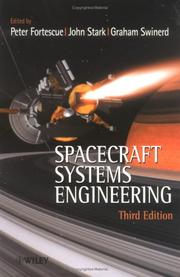| Listing 1 - 4 of 4 |
Sort by
|
Book
ISBN: 128192699X 9786611926991 0387765727 0387765719 1441926291 9780387765716 Year: 2008 Publisher: New York : Copernicus Books : In association with Praxis Pub.,
Abstract | Keywords | Export | Availability | Bookmark
 Loading...
Loading...Choose an application
- Reference Manager
- EndNote
- RefWorks (Direct export to RefWorks)
About half a century ago a small satellite, Sputnik 1, was launched. The satellite did very little other than to transmit a radio signal to announce its presence in orbit. However, this humble beginning heralded the dawn of the Space Age. Today literally thousands of robotic spacecraft have been launched, many of which have flown to far-flung regions of the Solar System carrying with them the human spirit of scientific discovery and exploration. Numerous other satellites have been launched in orbit around the Earth providing services that support our technological society on the ground. How Spacecraft Fly: Spaceflight Without Formulae by Graham Swinerd focuses on how these spacecraft work. The book opens with a historical perspective of how we have come to understand our Solar System and the Universe. It then progresses through orbital flight, rocket science, the hostile environment within which spacecraft operate, and how they are designed. The concluding chapters give a glimpse of what the 21st century may hold in terms of human exploration of the Solar System and more futuristic propulsion technologies for interstellar travel. Graham Swinerd invites you to understand "how spacecraft fly," while becoming a convincing rocket scientist along the way!
Astronautics --- Space flight --- Rocket flight --- Space travel --- Spaceflight --- Physics. --- Observations, Astronomical. --- Astronomy --- Astronomy. --- Aerospace engineering. --- Astronautics. --- Astronomy, Observations and Techniques. --- Popular Science in Astronomy. --- Aerospace Technology and Astronautics. --- Observations. --- Aeronautics --- Astrodynamics --- Interplanetary voyages --- Navigation (Astronautics) --- Flights --- Space sciences --- Space vehicles --- Astronomy—Observations. --- Aeronautical engineering --- Engineering --- Astronomical observations --- Observations, Astronomical --- Space flight. --- Vol spatial. --- Astronautique.
Book
ISBN: 9780387765723 9780387765716 Year: 2009 Publisher: New York NY Springer New York
Abstract | Keywords | Export | Availability | Bookmark
 Loading...
Loading...Choose an application
- Reference Manager
- EndNote
- RefWorks (Direct export to RefWorks)
About half a century ago a small satellite, Sputnik 1, was launched. The satellite did very little other than to transmit a radio signal to announce its presence in orbit. However, this humble beginning heralded the dawn of the Space Age. Today literally thousands of robotic spacecraft have been launched, many of which have flown to far-flung regions of the Solar System carrying with them the human spirit of scientific discovery and exploration. Numerous other satellites have been launched in orbit around the Earth providing services that support our technological society on the ground. How Spacecraft Fly: Spaceflight Without Formulae by Graham Swinerd focuses on how these spacecraft work. The book opens with a historical perspective of how we have come to understand our Solar System and the Universe. It then progresses through orbital flight, rocket science, the hostile environment within which spacecraft operate, and how they are designed. The concluding chapters give a glimpse of what the 21st century may hold in terms of human exploration of the Solar System and more futuristic propulsion technologies for interstellar travel. Graham Swinerd invites you to understand "how spacecraft fly," while becoming a convincing rocket scientist along the way!
Physics. --- Astronomy. --- Popular Science in Astronomy. --- Aerospace Technology and Astronautics. --- Astronautics. --- Physique --- Astronomie --- Astronautique --- Astronautics --- Space flight

ISBN: 0471619515 9780471619512 0470851023 Year: 2003 Publisher: Chichester Wiley
Abstract | Keywords | Export | Availability | Bookmark
 Loading...
Loading...Choose an application
- Reference Manager
- EndNote
- RefWorks (Direct export to RefWorks)
Space research --- Astronautics --- Space vehicles --- Systems engineering. --- Design and construction. --- Design and construction --- Systems engineering
Book
ISBN: 9780470750124 9781119971016 9781119971009 9781119978367 9781119978374 128324036X 9786613240361 1118302982 1119971004 1119971012 Year: 2011 Publisher: Chichester : Wiley,
Abstract | Keywords | Export | Availability | Bookmark
 Loading...
Loading...Choose an application
- Reference Manager
- EndNote
- RefWorks (Direct export to RefWorks)
"Updated edition of this bestselling & well-established introductory guide to the engineering of spacecraftThoroughly revised and updated, this fourth edition of Spacecraft Systems Engineering provides the reader with comprehensive coverage of all the different areas of engineering required in the design and implementation of spacecraft and space missions. The authors describe the workings of various types of spacecraft systems together with the essential disciplines which ensure that they work reliably and in harmony with each other. With emphasis on recent developments in space activities, all chapters have been rewritten with major revisions to the chapters on launch vehicles, structures, ground stations and mechanisms, and a brand new chapter on Assembly, Integration and Test. Spacecraft Systems Engineering, 4th edition begins with front-end system level issues such as environment, mission analysis and system engineering, and progresses to a detailed examination of subsystem elements which represent the core of spacecraft design - mechanical, electrical, propulsion, thermal, control etc. This quantitative treatment is supplemented by an appreciation of the interactions between the elements, which deeply influence the process of spacecraft systems design" "Thoroughly revised and updated, this fourth edition of Spacecraft Systems Engineering, 4th edition provides the reader with comprehensive coverage of all the different areas of engineering required in the design and implementation of spacecraft and space missions"
Space vehicles --- Astronautics --- Design and construction. --- Systems engineering. --- Astronautics -- Systems engineering --- Materials -- Congresses --- Space vehicles -- Design and construction --- Structural dynamics -- Congresses --- TECHNOLOGY & ENGINEERING / Aeronautics & Astronautics --- Mechanical Engineering --- Engineering & Applied Sciences --- Aeronautics Engineering & Astronautics --- Systems engineering --- Design and construction
| Listing 1 - 4 of 4 |
Sort by
|

 Search
Search Feedback
Feedback About UniCat
About UniCat  Help
Help News
News